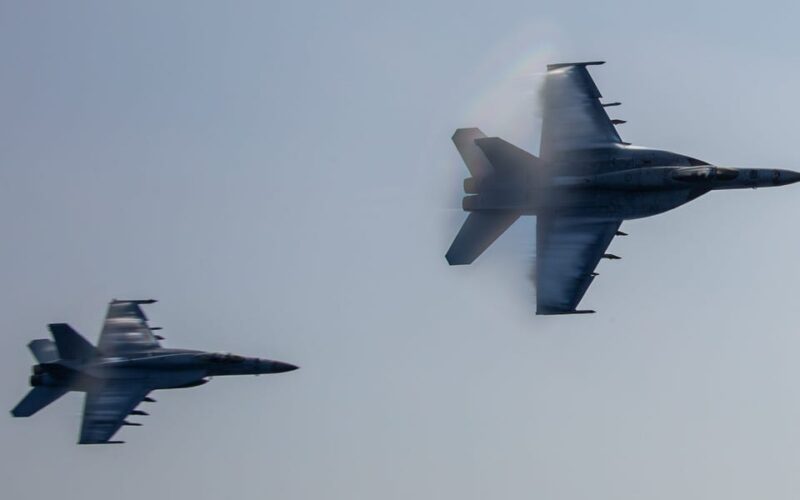- Israel’s killing of Hezbollah leader Hassan Nasrallah has put the Middle East even more on edge.
- The US said in response that it planned to adjust its force posture in the region.
- A powerful force of American warships and fighter aircraft are already on station, with more to come.
The US military has a substantial force of warships and fighter aircraft stationed across the Middle East and is moving even more firepower into the region as it braces for a potential increase in conflict.
The Middle East, already in turmoil after almost a year of fighting, was further rocked by Israel’s killing of Hassan Nasrallah, the longtime leader of the Iran-backed militant group Hezbollah, in a massive airstrike in the Lebanese capital of Beirut on Friday.
The assassination of Nasrallah marked a major escalation in the yearlong conflict and came amid increased Israeli military pressure on Hezbollah, raising concerns that the two bitter enemies could be heading toward an all-out war that could draw in US forces and possibly Iran as well.
The US has publicly stated that it is ready to defend Israel and protect its forces in the Middle East from any attack by Iran or its regional proxies.
US Navy photo
Amid increases in the intensity of the fighting, the US was already bracing for further violence. In a statement on Nasrallah’s death, President Joe Biden said on Saturday that he had directed Secretary of Defense Lloyd Austin the day before to “further enhance the defense posture of US military forces in the Middle East region to deter aggression and reduce the risk of a broader regional war.”
Pentagon Press Secretary Maj. Gen. Pat Ryder then said on Sunday that the US “retains the capability to deploy forces on short notice,” He added that the military maintains a “significant” presence in the region and can adjust its force posture “based on the evolving security situation.”
As part of these efforts, Ryder said Austin directed the Abraham Lincoln Carrier Strike Group to remain in the Middle East region, where it has been operating for several weeks. The strike group consists of the aircraft carrier USS Abraham Lincoln and several destroyers.
Austin also ordered the Wasp Amphibious Ready Group to stay in the Eastern Mediterranean, where it has been for several months.
US Navy photo
This assortment consists of the multipurpose amphibious assault ship USS Wasp and its embarked 24th Marine Expeditionary Unit, which can be deployed to evacuate Americans. Additionally, the ARG includes a dock landing ship and an amphibious transport dock vessel.
Beyond the CSG and ARG, the US Navy has additional destroyers operating in the Middle East and the Eastern Mediterranean.
The American warships are complemented by land-based aircraft, including F-22s, F-15s, F-16s, and A-10s delivering fifth-generation stealth and fourth-generation combat capabilities, as well as proven ground-attack options. Ryder said the US will “further reinforce our defensive air-support capabilities in the coming days.”
“The Secretary has also increased the readiness of additional US forces to deploy, elevating our preparedness to respond to various contingencies,” Ryder said.
US Navy photo
The Pentagon disclosed on Monday that it is sending additional forces, including fighter squadrons, to the region. It previously said it would send a small number of additional troops, but the details weren’t clear.
The changes to US force posture in the region followed a massive uptick in Israeli military pressure on Hezbollah, which began earlier in the month with a sophisticated pager attack and later shifted to devastating airstrikes targeting militant assets. Scores of civilians have also been killed and wounded.
The Israeli strikes have dealt a serious blow to Hezbollah, including eliminating its leadership, but the heavily armed militant group has suggested that it is still ready for war.
Israeli officials, meanwhile, continue to hint that the country is gearing up for an expanded ground invasion of Lebanon, which would be Israel’s first such operation since 2006 and would mark another major escalation in the conflict.
REUTERS/Ayal Margolin
“The elimination of Nasrallah is a very important step, but it is not the final one,” Israeli Defense Minister Yoav Gallant told troops near the northern border with Lebanon on Monday.
“Our goal is to ensure the [safe] return of Israel’s northern communities to their homes. We are prepared to make every effort necessary to accomplish this mission,” Gallant said. “We will use all the means that may be required — your forces, other forces, from the air, from the sea, and on land.”
It is unclear whether a final decision on the ground invasion has been made. On Monday, it was reported that Israeli special operations forces were conducting raids into Lebanon in preparation for a possible invasion. Diplomatic efforts to bring Israel and Hezbollah to a negotiating table have been unsuccessful.
Source link
lol

